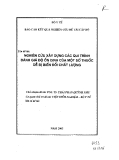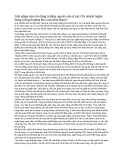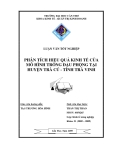JOURNAL OF FOREST SCIENCE, 53, 2007 (3): 101–112
Multivariate statistical approach to comparison of the nutrient status of Norway spruce (Picea abies [L.] Karst.) and top-soil properties in differently managed forest stands
P. Samec1, D. Vavříček2, P. Šimková2, J. Pňáček3
1Forest Management Institute Brandýs nad Labem, Frýdek-Místek Branch, Frýdek-Místek, Czech Republic 2Faculty of Forestry and Wood Technology, Mendel University of Agriculture and Forestry Brno, Brno, Czech Republic 3Forests of the Czech Republic, State Enterprise, Jeseník Forest District, Jeseník, Czech Republic
ABSTRACT: The soil is an irreplaceable component of forest ecosystems. Soil-forming processes directly influence element cycling (EC). Plant-soil interaction is a specific part of EC. Plant-soil interactions were observed on an example of natural spruce stand (NSS), semi-natural spruce stand (SNSS) and allochthonous spruce stand (ASS) in conditions of the spruce forest altitudinal zone (1,140–1,260 m a.s.l.; +3.0°C; 1,200 mm) of the Hrubý Jeseník Mts. (Czech Republic, Central Europe), where Norway spruce (Picea abies [L.] Karst.) is the main edificator and stand-forming tree species. We evaluated the soil properties of H- and Ep-horizons at selected sites with Haplic and Skeletic Podzols and they were compared with the nutrient status of spruce. A method of the principal component analysis was used for defini- tion of the basic hypotheses: (1) each forest stand is in specific and topically individual interactions with soil and these interactions influence its state, (2) the influence of forest management reflects in humification and in the nutrient status in plant assimilatory tissues. Cluster analysis calculated results comparable with the multivariate analysis of variance. The results show that the continuity of linear and multivariate statistical methods gives the approach to detection of the forest stage based on soil and plant tissue data.
Keywords: Norway spruce (Picea abies [L.] Karst.); humification; nutrition; cation exchange capacity (CEC); principal component analysis
the sorption complex. Because colloid humus com- pounds are important vectors of sorption properties of soil, long-term disturbance of humification proc- esses may be connected with disorders of the health status of biocoenoses and their decline (Ulrich 1995; McLaughlin, Percy 1999; Purdon et al. 2004; Modrzyński 2003).
Tree species nutrition is monitored according to the element composition of assimilatory tissues as one of the effects of plant and environment interac- tions (Begon et al. 1987). Special attention is usually paid to elements the plant takes up significantly or obligatorily from soil and the dynamics of which depends on litterfall decomposition on the soil surface (Hyvönen et al. 2000; Novák, Slodičák 2004; Vera 1992; Pasuthová, Lomský 1998). In soil these elements are bound in exchange bonds of
Humification processes in forest ecosystems have been significantly disturbed by an air pollution load. A significant loss of the overlying humus reserve in
Supported by the Ministry of Education, Youth and Sports of the Czech Republic, Project No. MSM 6215648902, and by the Czech Science Foundation, Project No. 526/03/H036.
J. FOR. SCI., 53, 2007 (3): 101–112
101
and (3) in managed stands changes occurred in soil sorption properties and soil buffer system. The aim of this study was to compare the correctness in linear and multivariate models of the soil system data.
MATERIAL AND METHODS
Theory about site survey
forests is an indicator of disturbed element cycles in forest ecosystems in spite of a decreasing air pol- lution load. Long-term changes in the quality and quantity of organic matter humification in forests are among the indicators of soil disturbances. The soil dysfunctions that are among the factors of forest decline (Modrzyński 2003) cause that symptoms of decline appear both in natural and in managed for- ests even though each forest ecosystem has different specific interactions with its environment. Drought or frost is a direct cause of obvious symptoms of forest decline (Čermák et al. 2005). Specific impacts of their effects on the tree health are connected with physiological dysfunctions between needles (leaves) and root system. The functional connection of roots with the soil as well as with the other tissues of the plant is related to soil water-holding capacity and to the potential of ion exchange reactions. In case that the neutralisation of naturally adverse soil conditions by the activity of humus compounds is impossible, the potential of forest ecosystem stability dimin- ishes and the risk of its predisposition to decline increases (Vavříček et al. 2005). Problems occur in approaches of evaluation. Any ecosystem study needs statistics but chemical data are sensitive to the non-performance of normal distribution (Webster 2001). Especially the acquisition of forest and soil data was restricted by a small sample size (Meloun et al. 2001).
The Hrubý Jeseník Mts. are an important geo- tectonic unit of the northeastern part of the Bo- hemian Massif (in the direction north – south 50°13´07´´–49°56´17´´N, in the direction west – east 16°56´43´´–17°23´06´´E). It is situated at the altitude of 550–1,491 m above sea level (average tem- peratures 0.9–6.3°C; annual precipitation 1,048 to 1,377 mm). Tectonically, it is broken up into the mountainous massifs of Keprník Mt. (1,423 m a.s.l.), Praděd Mt. (1,491 m a.s.l.), Orlík Mt. (1,204 m a.s.l.) and Mravenečník Mt. (1,432 m a.s.l.). The summit parts of uplands have conditions for the vegetation of the spruce forest altitudinal zone (FAZ) (dominant associations of Calamagrostio villosae-Piceetum and Sphagno-Piceetum) (cf. Culek 1996; Jeník, Fabiszew- ski 1992). Norway spruce (Picea abies [L.] Karst.) is the main edificator and stand-forming tree species in mountain spruces stands of Central Europe. The timberline is running quite near the Praděd summit (about 1,340 m a.s.l.) with differential vegetation of the alliance Salicion silesiacae.
The closeness of the correlation of element cycles with organic matter increases in mountain condi- tions near the timberline. During pedogenesis at these locations processes of podzolization are usu- ally inevitable. Thus soils with eluvial horizon Ep and illuvial diagnostic horizon Bs are formed (Vavříček, Šimková 2000). Intensive natural elution of ele- ments from soil, naturally high soil acidity and high concentrations of Al3+ foreshow the existence of rhizosphere only in close relations with the overlying humus. If natural forests have undisturbed self-regu- latory relations with soil whereas in managed stands these relations have been disturbed to a different extent, we can assume that: (1) in managed forest stands changes occurred in element cycles and tree nutrition; (2) in managed stands heterogeneity of hu- mus forms and their properties have been changing,
The state of mountain forests in this area is dif- ferentiated in relation to terrain accessibility and division. Susceptibility of mountain forests to decline and dieback increased as a consequence of long- term exploitation and air-pollution stress (Huettl, Mueller-Dombois 1993; Kriegel 2000; Balcar 2001). Even though the annual air concentration of SO2 in the area concerned amounts to 5–25 μg/m3 and is evaluated as risk-free (cf. Maňkovská 1988), all the time the forest stands are threatened by ex- treme meteorological phenomena, fluctuations of soil moisture and many pests. Localities character- istic of central uplands of the Hrubý Jeseník Mts., where natural spruce stand, spruce stand influenced by silvicultural activities and left to natural develop-
Table 1. Some basic mensurational data of the RPs (according to Pňáček 2006)
Mean stem Spruce stand Standing volume (m3/ha) Stand basal area (m2/ha) h (m) d1.3 (cm) Natural 27.34 37.86 531.66 44.43 Semi-natural 20.96 43.15 374.94 39.39 Allochthonous 16.97 37.39 175.86 22.24
J. FOR. SCI., 53, 2007 (3): 101–112
102
of Forest Development (Burian 2001) and another documents about forest history (unpublished facts).
ment, and permanently managed spruce stand are represented in the conditions of spruce FAZ, were chosen as the study area.
Description of study plots
In the area of the National Natural Reserve Šerák – Keprník (Keprník Uplands) the RPs of natural and semi-natural spruce stands were demarcated in stand 225B17p (1,140–1,260 m a.s.l.). The natural spruce stand (NSS) is represented by a fragment of virgin mountain ecosystem (SP 1–5). The semi- natural spruce stand (SNSS) is an ecosystem where felling as well as tree planting were carried out in the past and then it was left to spontaneous develop- ment (SP 6–10). The parent rocks of these localities are weathered biotitic-muscovitic gneisses. The soil type is Haplic Podzol [O–Ep(Ae)Ep–Bhs–Bs–B/ C–C]. The allochthonous spruce stand (ASS) was discovered on the slope of Malý Děd Mt. (1,355 m a.s.l.) (Praděd Uplands) in stand 320C15 (1,230 m a.s.l.) (SP 11–15). The parent rocks of this local- ity are colluvial deposits of weathering products of biotitic-muscovitic phyllites and vein quartzes. The soil type is Skeletic Podzol (O–Ep–Bhs–Bs–B/C–C). The surface humus is described as Hemimor on all plots (Green et al. 1993).
Sampling and pedochemical analyses
Study plots were selected on the basis of compa- rable conditions of the spruce forest altitudinal zone and ecological series with generally identical soil- forming processes (podzolization) and on the basis of different impacts of management. The currently minimized level of air-pollution load in the whole area is an important aspect of ecology of these plots. It is a necessary condition for effective humification processes and element translocation in the ecosystem. Differences in the chemical composition of assimila- tory tissues and overlying humus were evaluated in selected forest stands in order to quantify the aspects of humus genesis in differently managed mountain for- est ecosystems. Three typical mountain spruce stands were chosen. In each of these stands a representative plot (RP) 50 × 50 m in size was demarcated. On these RPs five sampling points (SPs) were selected at five medium-stem spruce sample trees (Table 1). The age of stands is about 160 and 170 years. The natural stage of stands was reviewed partly by the methods of the habitual description of a tree phenotype (Kantor 1971), partly by a literature survey in the Regional Plan
Samples were taken in autumn 2005. Samples of branches with current-year needles and another
Table 2. MANOVA/ANOVA for the heterogeneity of properties in the soil bodies [CEC (mmol/kg); exchangeable ions (mg per kg); Cox (%); Nt (%); plant tissue elements (g/kg) and textural fractions (%)]
–x ± σ
Soil properties Quantity SS MS F F0.05 10.88 5.44 3.36 4.00 ± 0.50 7.12 Physicochemical pH/H2O pH/KCl 3.52 ± 0.58 134.03 ± 25.06
125.32 ± 23.70 0.32 0.16 0.15 3.17
1.36 ± 1.49
2.55 ± 0.97 Chemical CEC H+ K+ Mg2+ Ca2+ 4.79 ± 3.01 13.47 ± 14.41 0.70 ± 0.63 Cox Nt clay 10.63 ± 5.64 0.00 0.00 0.00 3.26 silt 14.02 ± 4.96 Textural silty sand 18.34 ± 5.13 sand 57.02 ± 9.86 N 1.24 ± 0.13 0.46 0.23 0.74 3.04 P 1.15 ± 0.07 Mg 0.72 ± 0.26 Plant tissue chemistry Ca 3.39 ± 0.97 K 4.40 ± 0.82
SS – square sum; MS – mean square; F – Fisher-Snedecor’s criterion
J. FOR. SCI., 53, 2007 (3): 101–112
103
two vital needle-years were taken from each Nor- way spruce sample tree from the upper third of the green part of crown. Nitrogen, phosphorus, calcium, magnesium and potassium were determined in in- dividual needle classes. Nitrogen was determined coulometrically. The other elements were deter- mined by an extraction-spectrophotometric method (Zbíral 1994).
was usually done on a standard significance level P < 0.05. The basic assumptions about data were as- sessed by exploratory data analysis (EDA) according to the assumptions of normality, correlativity and empirical sample size (Meloun et al. 2001). The values of arithmetical means (x– ), medians (x~ ) and standard deviation (σ) were calculated. Normality was evaluated from the computations of skewness and peakedness coefficients and by their comparison with empirical criterion 1.96 (Zar 1994).
Data correlativity was taken as an assumption for multivariate analyses (Siotani et al. 1985). Simple correlations were evaluated as low when their sig- nificance was in the interval P < 0.50–0.05. High correlations were evaluated at P < 0.05. Multivariate correlativity was tested by factor analysis (FA). By means of FA the number and character of factors were found out that could be considered for cluster analysis (CLU) and principal component analysis (PCA) (Johnson 1998). Alternatively to CLU multi- variate analysis of variance (MANOVA) was applied. CLU and MANOVA were used to evaluate the close- ness of the nutrient status of the spruce stands and to assess the closeness of chemical properties of the studied sites. The results were tested by PCA. To test the homogeneity of soil properties of studied RPs analysis of variance (ANOVA) was applied.
RESULTS
Under the crown of each sample tree samples of H-horizon and Ep-horizon (top-soil horizons) were taken. The soil profile was described according to the World Reference Base for soil resources (Dries- sen et al. 2001) and its complex characteristics were identified. The soil texture was determined by a hy- drodynamic sedimentation method (Pelíšek 1964). Soil acidity (pH/H2O and pH/KCl) was measured with a conjunct glass electrode (soil/H2O or 1M KCl = 1/2.5). Cation exchange capacity (CEC) was defined by the Mehlich method (Zbíral 2002). The available mineral nutrition (Ca2+, Mg2+, K+) was determined by atomic absorption spectrophotometry from extracts by Mehlich II method. Content of phosphorus was determined by spectrophotometry in the solution of ascorbic acid, H2SO4 and Sb3+ (Mehlich 1978). Analyses of plant available nutrients in H-horizon were carried out in Göhler extract at a soil/extract ratio = 1/10, whereas phosphorus content was deter- mined in the presence of CH3COONa+CH3COOH. The content of oxidizable organic carbon (Cox) was determined by the oxidation of H2Cr2O7+H2SO4 when no consumed chrome acid was determined by titration of Mohr salt solution. Total nitrogen (Nt) content was determined by Kjeldahl method (Zbíral et al. 1997).
Statistical analyses
Based on the satisfaction of basic assumptions about the population statistical evaluation of data
Pedochemical properties of top-soil horizons show that potential sources of available nutrients are localized in H-horizon. It is obvious that ASS is different from the other RPs in the values of Cox, P, Mg and K. The pH value of Ep-horizon in ASS is the lowest of all RPs. Although each RP is situated on a specific substrate, no significant differences in substrate properties or soil texture were detected by ANOVA or MANOVA (Table 2). Potential dif-
Table 3. The contents of selected biogenic elements from spruce needles [P, Mg, Ca, K (g/kg); N (%)]
Spruce stand N P Mg Ca K Needle age (years) 1 1.28 ± 0.11 1.49 ± 0.32 1.06 ± 0.18 2.99 ± 0.55 4.31 ± 0.54 2 1.17 ± 0.20 1.15 ± 0.18 0.78 ± 0.23 3.48 ± 0.40 3.78 ± 0.52 Natural 3 1.13 ± 0.09 1.03 ± 0.24 0.59 ± 0.18 3.49 ± 0.60 4.04 ± 0.72 1 1.26 ± 0.09 1.14 ± 0.09 0.93 ± 0.24 2.74 ± 1.01 5.72 ± 0.35 2 1.21 ± 0.15 1.14 ± 0.08 0.66 ± 0.27 3.10 ± 1.44 4.75 ± 0.52 Semi-natural 3 1.18 ± 0.17 1.04 ± 0.08 0.52 ± 0.28 4.38 ± 0.44 3.34 ± 1.68 1 1.29 ± 0.09 1.15 ± 0.23 0.80 ± 0.18 3.11 ± 0.46 4.66 ± 0.89 2 1.34 ± 0.08 0.98 ± 0.16 0.64 ± 0.17 3.89 ± 0.76 4.42 ± 0.77 Allochthonous 3 1.27 ± 0.08 0.90 ± 0.08 0.50 ± 0.16 4.10 ± 0.73 3.89 ± 0.81
J. FOR. SCI., 53, 2007 (3): 101–112
104
0.8
) t n a l
p –
P (1-yr old) P (2-yrs old) 0.6 Fig. 1. Factor analysis for presumed correlations of H-horizon properties and spruce nutrient status P (3-yrs old) K (1-yr old) Mg (2-yrs old) 0.4 Mg (3-yrs old)
0.2
l i o s ( r o t c a f n o i t i s o p
0.0
–0.2
l a n o i t c n u F
–0.4
–0.6
ferences were identified as calculated interactions between the components of statistical variability. In the computations of correlation matrices the values of means were correlative. When x~ was used, no correlations were found out. The values of means describe the nutrient status of spruce needles and soil chemistry much better.
were obtained after comparison of the particular sample trees. On data generalization to the observed stands no statistical differences were detected. But differences in calculated correlation coefficients demonstrate that a different correlative level may be a signal of differences in needle chemistry from the selected spruce stands at low significance. Also MANOVA detected differences in element contents of H-horizons on the particular RPs as statistically significant. Ca2+ content was found to be statistically different between RPs in both top-soil horizons. But NSS and ASS have corresponding Ca2+ contents and CEC in H-horizon. Similarly, Nt does not provide unambiguous information to detect clear differences between RPs and their trophic potential.
The analysis of chemical composition of three needle years showed that nitrogen behaved as a stable element while its content in the biomass of assimilatory tissues of spruce did not practically change; phosphorus and magnesium contents de- crease with increasing needle age whereas calcium content increases (Table 3). MANOVA indicated that some differences in element concentrations in needles (R-ndls) between RPs were significant. Sta- tistically significant differences in needle chemistry
FA confirmed the assumed differences between the values of soil nutrients and R-ndls. These differences
–0.8 –0.6 –0.4 –0.2 0.0 0.2 0.4 0.6 0.8 1.0 Variability
Table 4. Correlation matrix of statistical relationships between average nutrient contents in top-soil horizons and spruce needles at P < 0.50
Horizon Element N-ndls P-ndls Mg-ndls Ca-ndls K-ndls 0.44 –0.16 –0.20 Nt P 0.33 –0.52 0.29 Mg 0.31 –0.46 0.30 H Ca 0.25 –0.19 0.16 K 0.35 –0.42 0.20 0.31 –0.30 –0.27 Nt P 0.30 0.20 Mg 0.34 –0.29 –0.20 0.34 0.34 Ep Ca –0.34 –0.28 –0.43 –0.27 K 0.43 –0.19 –0.28 0.28 0.26
J. FOR. SCI., 53, 2007 (3): 101–112
105
Table 5. Correlations of the average content of elements from spruce needles (bold P < 0.05)
N-ndls Mg-ndls Ca-ndls K-ndls P-ndls Element * 0. 16 0.38 0.35 N-ndls 0.54 * –0.20 0.40 P-ndls 0.50 * 0.26 0.28 Mg-ndls * Ca-ndls * K-ndls
Table 6. Chemical and physicochemical properties of the top-soil horizons [CEC (mmol/kg); Cox (%); Nt (%); C/N (1); elements (mg/kg)]
from H-horizon, but it is close to phosphorus from Ep-horizon. Soil Ca was evaluated as quantitatively distant from Ca-ndls. The computed correlation matrix indicates some specifics in feedbacks be- tween assimilatory tissues and top-soil chemistry (Table 4). ANOVA of top-soil and complete soil profile properties shows differences resulting from specific elementary dynamics at organic or inorganic structures.
Within the correlations of the whole population correlation coefficients (r) ≥ 0.16 were calculated for
are statistically related with specific interactions of the plant and the particular soil horizon (Fig. 1). We evaluated the factors influencing correlations such as (1) variability of elements in the plant tissue and (2) localization of an element in the studied parts of ecosystem (plant × soil). In H-horizons the elements seem to be slowly mobile and quantitatively their val- ues are different from those in assimilatory tissues. P-ndls showed the lowest probability of transloca- tions. Ca-ndls was also evaluated as relatively immo- bile. P-ndls is statistically distant from phosphorus
H-horizon (8–16 cm) Ep-horizon (15–26 cm) Quantity NSS SNSS ASS NSS SNSS ASS 3.59 ± 0.06 3.46 ± 0.13 3.50 ± 0.28 3.83 ± 0.10 3.83 ± 0.37 3.74 ± 0.17 2.96 ± 0.12 2.98 ± 0.22 2.79 ± 0.31 3.21 ± 0.11 3.48 ± 0.42 3.07 ± 0.21 pH/H2O pH/KCl 153.33 ± 5.89 140.20 ± 7.64 148.42 ± 16.89 123.24 ± 10.54 119.81 ± 8.21 118.87 ± 28.45 CEC 32.98 ± 6.59 34.74 ± 3.20 42.34 ± 2.12 7.83 ± 1.38 9.21 ± 1.29 11.23 ± 3.05 1.70 ± 0.28 1.58 ± 0.14 1.95 ± 0.22 0.49 ± 0.11 0.51 ± 0.13 0.61 ± 0.13 19.36 ± 1.82 22.06 ± 1.64 21.96 ± 2.44 16.48 ± 3.27 19.37 ± 6.98 18.40 ± 3.16 Cox Nt C/N 9.20 ± 3.03 6.20 ± 4.15 21.60 ± 13.09 6.10 ± 5.19 0.81 ± 0.12 2.00 ± 2.79 P 44.60 ± 8.35 36.60 ± 5.77 58.60 ± 2.07 29.60 ± 3.36 29.60 ± 4.98 38.00 ± 8.00 Mg 188.20 ± 42.23 142.80 ± 14.06 207.40 ± 31.08 90.60 ± 25.22 47.40 ± 13.52 81.60 ± 22.51 Ca 159.20 ± 11.54 137.80 ± 7.16 188.60 ± 29.39 31.80 ± 16.08 31.40 ± 10.69 65.80 ± 39.39 K
.
.
% 4 0 2 2
% 0 0 1 2
: r o t c a f n o i t i s o p
: r o t c a f n o i t i s o p
l a n o i t c n u F
l a n o i t c n u F
4 4 8 7 1 3 2 11 7 4 2 3 2 10 9 2 7 4 15 0 6 12 9 6 8 0 10 5 –2 13 12 1 13 –2 –4 14 15 11 14 –4 –6 –4 –2 0 4 –6 –6 –4 –2 0 4 2 Factor of variability: 30.89% 2 Factor of variability: 30.48%
Fig. 3. Projection of SPs (plant × Ep-horizon) to the factor level Fig. 2. Projection of SPs (plant × H-horizon) to the factor level
J. FOR. SCI., 53, 2007 (3): 101–112
106
Table 7. Correlations of the spruce nutrient status due to specific stand conditions
Spruce stand Element N-ndls Mg-ndls Ca-ndls K-ndls P-ndls
low correlations and r > 0.50 for high correlations. High correlations between phosphorus, magnesium and nitrogen were determined in the values of R-ndls (Table 5). Potassium and calcium contents were in a low correlation with these elements. High correla-
tions between soil and plant tissue elements were not detected. The r values for R-ndls and available soil nutrients are different not only when the values from different soil horizons are evaluated but also they were found to be differentiated according to
N-ndls * 0.60 0.74 0.63 P-ndls * 0.57 0.74 Natural Mg-ndls * 0.68 Ca-ndls * K-ndls * N-ndls * 0.85 0.59 P-ndls * 0.60 0.85 Semi-natural Mg-ndls * 0.68 Ca-ndls 0.54 * K-ndls *
90 100
y t i r a l i
y t i r a l i
m
m
i s s i D
i s s i D
90 80 80 70 70 60 60 50 50 40 40 30 30 20 20 10 10 0 0 15 14 11 12 5 4 13 3 2 8 7 9 10 6 1 14 11 7 6 9 10 8 2 13 12 15 4 5 3 1
Fig. 5. Weighted pair-group averages of CLU of the correlativ- ity of Ep-horizon properties in relation to particular SPs Fig. 4. Weighted pair-group averages of CLU of the correlativity of H-horizon properties in relation to particular SPs
600 350
300 500
y t i r a l i
y t i r a l i
250 400
m
m
i s s i D
i s s i D
200 300 150 200 100
100 50
0 0 Ca K CEC Mg Ca CEC K Mg Cox P Nt pH/H2O Cox P Nt pH/H2O pH/KCl pH/KCl
Fig. 6. Weighted pair-group averages of CLU of the correlativity in H-horizon properties Fig. 7. Weighted pair-group averages of CLU of the correlativity in Ep-horizon properties
J. FOR. SCI., 53, 2007 (3): 101–112
107
Table 8. Specific correlations between element contents from top-soil horizons and spruce needles due to characteristic stand conditions (bold P < 0.05)
s e l d e e n
l a r u t a N
l i o s
s e l d e e n
l a r u t a n - i
m e S
l i o s
s e l d e e n
s u o n o h t h c o
l l
A
l i o s
N-ndls, P-ndls and Mg-ndls (Table 8). Generally, cor- relations of phosphorus values from H-horizon and tissue data cannot be compared with correlations from Ep-horizons.
The sample of properties of H-horizons has the traits specific to the particular RPs (Table 6). Based on these traits it is possible to define SNSS and ASS reliably. The diversity of H-horizon properties is such that it penetrates into the intervals of values and SPs from ASS (Fig. 2). The properties of Ep-horizons do not show the specificities of RPs reliably (Fig. 3). CLU with single linkage (method of the nearest neighbour) does not exclude the hypothesis about RP characteristics but CLU with the use of weighted
the RPs. The division of the basic population into partial value samples applicable to the particular RPs resulted in a change in the significance of r. Low cor- relations were r > 0.40. High correlations were only r ≥ 0.88. The absence of correlations or their frequent low rates indicate the processes when the nutrient status of spruce stands (Table 7) does not strictly depend on the element uptake from soil or such a correlation is not indispensable for plant nutrition. No significant correlations in spruce nutrient status from the ASS were found. The effects of nutrients from H- and Ep-horizons on the nutrient status of the studied spruce stands are obviously different. In SNSS and ASS Nt was in negative correlation with
H-horizon Ep-horizon Location Element Spruce stand P Mg Ca K P Mg Ca K Nt Nt 0.70 –0.40 0.79 N –0.97 0.74 –0.40 –0.50 0.57 –0.50 –0.81 P –0.49 –0.44 0.52 –0.50 –0.63 Mg 0.71 0.43 0.66 Ca 0.97 0.88 0.47 –0.44 0.46 –0.68 –0.75 K * * 0.77 –0.46 * –0.77 * 0.70 Nt P * 0.87 0.72 * Mg * * –0.86 Ca * * K –0.62 0.83 –0.84 0.53 –0.45 N 0.66 –0.46 –0.86 –0.58 0.58 0.75 P –0.92 –0.64 –0.47 0.41 0.53 Mg 0.97 –0.89 –0.64 –0.54 0.47 0.68 –0.54 Ca –0.54 –0.85 0.41 0.40 K 0.91 * 0.46 –0.49 * 0.81 –0.43 –0.65 –0.43 * –0.57 * –0.51 –0.64 –0.84 Nt P * * 0.67 Mg 0.96 * 0.70 * Ca –0.89 * * K –0.50 –0.44 –0.61 0.83 –0.48 N –0.51 –0.49 0.56 0.80 0.47 P –0.67 –0.79 –0.68 –0.56 Mg –0.49 0.70 –0.88 0.80 –0.58 –0.56 –0.78 Ca –0.95 –0.65 0.53 0.56 –0.57 0.87 K –0.90 0.89 * –0.48 –0.53 * –0.66 0.82 0.76 0.51 * –0.48 * –0.76 –0.68 Nt P –0.89 * 0.78 –0.56 * 0.46 Mg 0.98 * * Ca * * K
J. FOR. SCI., 53, 2007 (3): 101–112
108
pair-group averages supports an assumption about the generally homogeneous soil environment in all studied stands (Figs. 4 and 5). Specifically, the CEC is a quantity important for indication of site character- istics according to the different forest management or other ecological influences. MANOVA showed that the soil physicochemical properties were dif- ferent due to separation according to the particular (specifically managed) spruce stands.
why the values of N-ndls appear similar in the three studied needle years. This phenomenon may be con- nected with potential eutrophication and different air pollution deposition at forest sites. The different air-pollution load need not influence the dynamics of N input into assimilatory tissues but it could prob- ably influence the rate of its accumulation in plant tissues. The exposure to pollutants did not clearly enhance any nutrient deficiencies. However, distinct ultrastructural effects of fumigation and Mg and K deficiency stress, especially when applied together, were observed (Rantanen et al. 1994).
CLU explicitly indicates the rate of correlativity of soil properties. Figs. 6 and 7 document a set of soil properties associated with organic matter and a set of properties that are not directly controlled by the organic matter presence. The evaluation of H- and Ep-horizons provides somewhat different results again. In Ep-horizons the potential low cor- relation of Ca2+ with CEC was also determined. Mg2+ is more closely correlated with K+ than with Cox. It points to an assumption that each of the top-spoil horizons provides to plants a differently utilizable substrate. Nitrogen, organic carbon, phosphorus and soil acidity were found to be the soil properties associated with organic matter while CEC seems to be independent of organic matter and it correlates with calcium content.
DISCUSSION
Soil bivalent bases are physiologically important compounds. Even though it is possible to assume their close correlation with overlying humus in ex- posed mountain areas, such statistical relations were found out in the nutrient status of spruce-trees and soil characteristics on the studied RPs that do not make it possible to accept this assumption explicitly. Markedly lower concentrations of Mg2+ are usually determined in Ep-horizons than in surface humus. The primarily low reserve of magnesium in soil suggests increased susceptibility of forest stands to decline. If sites with a low natural reserve of magne- sium are afflicted by drought (cf. Dambrine et al. 1993), magnesium deficiency becomes a risk factor that can directly cause decline or dieback. Especially, plant predisposition to magnesium deficiency can be expected if any disturbances of calcium content occurred in biomass and surface humus. Without Ca2+ fine roots do not grow, and detoxication mecha- nisms, processes of acid neutralization and stability of plant tissues are disturbed.
Different rates of closeness of the correlations indicate different importance of the uptake of a particular nutrient from a particular soil horizon. Specifically, H-horizons are always markedly dif- ferent from organomineral or mineral soil horizons in qualitative terms. In conditions of the Central- European spruce FAZ (in mountain locations of the Bohemian Massif ) the importance of H-horizon properties for the element cycling (EC) is irreplace- able: (i) it is given by the fact that Norway spruce is a tree species with naturally shallow root system (Ge- bauer, Martinková 2005), (ii) strong eluviation under the formation of Ep-horizon makes a marked ecological barrier in the soil where deficiencies of available nutrients reduce the rhizosphere prosperity (Vavříček et al. 2005).
Multivariate statistical analyses indicate as advis- able to divide soil chemical and physicochemical properties into a biologically influenced group and a group independent of biological and biochemical soil properties. Even though the differences in texture are not statistically significant on RPs, insignificant differences are given by the dynamics of weathering and they were detected in Ca2+ availability in mineral top-soil horizons. The close correlation between CEC and calcium is probably connected with the proportion of actively sorptive soil clay. Soil acid- ity, organic carbon, total nitrogen and phosphorus content were found as explicitly depending on soil biochemistry. Other elements were detected in rela- tions specific to a particular soil horizon. In statisti- cal characteristics Mg2+ in H-horizons is closer to organogenic properties than to inorganic ones. In Ep-horizon its character is more similar to the con- tent of potassium, but both elements are closer to organogenic characteristics than to inorganic ones. Potassium from Ep-horizon is more easily utilizable
In the examined data the effects of nitrogen, cal- cium, magnesium and phosphorus on the nutrition of spruce stands were specific. Aboveground parts + uptake from the atmosphere. of trees prefer NH4 The uptake of physiologically available nitrogen by the crown plays an important role in total nitrogen balance in the plant (Eilers et al. 1992) but it does not influence total balance of P or K (Wilson, Ti- ley 1998). The additional uptake of nitrogen by the aboveground part of spruce-tree is a potential cause
J. FOR. SCI., 53, 2007 (3): 101–112
109
by plants than that from H-horizon. Its antagonism with bivalent bases is not evident here. At low Mg concentrations no particular element should prob- ably be preferred for plant nutrition, and so there are no negative correlations indicating antagonistic relations. CLU can also detect the potential correla- tivity in soil data although their sample is statistically small so that the correlations are computed at a low significance level. The normality and equivalence in EDA are the necessary presumptions for this pro- cedure. The equality of results in CLU and ANOVA provided information useful for the interpretation of PCA projections.
characteristics directly influenced by humification in H-horizons. The definition area of soil organogenic processes was identified by CLU. Differences in the properties of the particular sampling points and the fact that the influence of soil heterogeneity on the specificity of forest stand cannot be fully neglected complicate the interpretation of results. CLU and PCA indicated that the soil processes connected with humification and other biochemical reactions might have a differential importance in the description of heterogeneity of forest soil properties. The greatest heterogeneity of soil properties was observed in NSS. Characteristic differences at significantly lower heterogeneity of soil properties were determined for SNSS and ASS.
R e f e r e n c e s
BALCAR V., 2001. Umělá obnova lesních porostů v horských podmínkách. In: SLODIČÁK M., NOVÁK J. (eds.), Sou- časné otázky pěstování horských lesů. Opočno, VÚLHM: 135–138.
BEGON M., HARPER J.L., TOWNSEND C.R., 1987. Ecology. Individuals, Populations and Communities. Oxford, Lon- don, Edinburgh, Boston, Palo Alto, Melbourne, Blackwell Scientific Publications.
BURIAN J. (ed.), 2001. Oblastní plán rozvoje lesů (OPRL) PLO 27 Hrubý Jeseník. Brandýs nad Labem, pobočka Olomouc, ÚHÚL: 243. CULEK M. (ed.), 1996. Biogeografické členění České repub- liky. Praha, Enigma: 347.
ČERMÁK M., MARTINKOVÁ M., PALOVČÍKOVÁ D., JANKOVSKÝ L., 2005. About phytopathological and his- tological aspects of Norway spruce dieback in the Orlické hory Mts. Journal of Forest Science, 51: 348–358.
In all cases mainly Ca2+ was found to be an element apparently independent of biochemical processes. Probability of complexation with participation of Ca2+ occurs in favourable reaction conditions. It cannot be expected in strongly acid mountain soils. This may be the reason why the content of soil Ca2+ was statistically detected as independent of organogenic characteristics but dependent on CEC. It means that the precipitation of soil calcium carbonate depends on litter fall feed rate, calcium/ carbonate ratio, pH, complexing agents and their concentrations (Westin, Rasmuson 2003). Com- plexing agents, besides complexing calcium ions, influence the crystallization process by selectively inhibiting the growth of certain polymorphs of cal- cium carbonate. Quantitative data from fraction- ated chemical analyses in spruce needles document clearly that the oxalate serves as a binding site for surplus Ca2+. It becomes obvious that any Ca2+ transported into the needles in excess of the physi- ological needs becomes immediately precipitated as inactive oxalate, thereby maintaining a constant free Ca pool. This also means that the synthesis of oxalic acid is probably regulated by the amount of calcium entering the needles (Fink 1991). In humification processes the presence of some complexing agents (citrate) is important for plant Al-tolerance (Wehr et al. 2003).
DAMBRINE E., CARISEY N., POLLIER B., GRANIER A., 1993. Effects of drought on the yellowing status and the dynamics of mineral elements in the xylem sap of declining spruce (Picea abies L.). Plant and Soil, 150: 303–306.
DRIESSEN P., DECKERS J., NACHTERGAELE F. (eds.), 2001. Lecture Notes on the Major Soils of the World. Rome, FAO: 307.
CONCLUSION
EILERS G., BRUMME R., MATZNER E., FREEZER-SMITH P.H., 1992. Above-ground N-uptake from wet deposition by Norway spruce (Picea abies Karst.) – acidic deposition, its nature and impacts. Atmospheric pollution and forests. Forest Ecology and Management, 51: 239–249.
Each studied stand shows specific linkages with the soil environment. On the studied RPs differ- ences in the diversity of surface humus properties and differences in spruce nutrition were determined. Differences in site characteristics are reflected in the ecology of studied forest stands only marginally in the values of CEC, soil Ca2+, Mg2+ and PO4 3 –. At 3 – were found to be the the same time Mg2+ and PO4 factors of plant nutrition depending on soil humi- fication. C/N and soil acidity were evaluated as the
FINK S., 1991. Unusual patterns in the distribution of calcium oxalate in spruce needles and their possible re- lationships to the impact of pollutants. New Phytologist, 119: 41–51.
GEBAUER R., MARTINKOVÁ M., 2005. Structure and func- tions of the types of Norway spruce (Picea abies [L.] Karst.) roots. Journal of Forest Science, 51: 305–311.
J. FOR. SCI., 53, 2007 (3): 101–112
110
GREEN R.N., TROWBRIDGE R.L., KLINKA K., 1993. To- wards a Taxonomic Classification of Humus Forms. Forest Science (Monograph No. 29), 39: 49. forest health under long-term air pollution mitigated by lithological conditions. Forest Ecology and Management, 195: 355–371. RANTANEN L., PALOMÄKI V., HARRISON A.F., LUCAS
HUETTL R.F., MUELLER-DOMBOIS D., 1993. Forest Decline in the Atlantic and Pacific Regions. Amsterdam, Springer Verlag. P.W., MANSFIELD T.A., 1994. Interactions between com- bined exposure to SO2 and NO2 and nutrient content and uptake, growth, needle ultrastructure and pigments. New Phytologist, 128: 689–701. SIOTANI M., HAYAKAWA T., FUJIKOSHI Y., 1985. Modern HYVÖNEN R., OLSSON B.A., LUNDKVIST H., STAAF H., 2000. Decomposition and nutrient release from Picea abies (L.) Karst. and Pinus sylvestris L. logging residues. Forest Ecology and Management, 126: 97–112. Multivariate Statistical Analysis. A Graduate Course and Handbook. Columbia, American Science Press. ULRICH B., 1995. The history and possible cause of forest JENÍK J., FABISZEWSKI B., 1992. The Giant Mountains: An endangered heritage in Central Europe. Annales Silesiae, 22: 7–14. decline in Central Europe, with particular attention to the JOHNSON D.E., 1998. Applied Multivariate Methods for Data German situation. In: EC, UN/ECE, Forest Soil Condition Analysis. Pacific Grove, Duxbury Press, ITP. in Europe. Results of a Large-Scale Soil Survey. Technical Report, Brussels, Geneva: 261. VAVŘÍČEK D., ŠIMKOVÁ P., 2000. Půdní prostředí přirozených smrčin 8. lvs Krkonoš. Opera Corcontica, 37: KANTOR J., 1971. Šlechtění smrku pro oblast Hrubého Jeseníku. In: CAMPANULA – Sborník přírodovědných prací z chráněné krajinné oblasti Jeseníky. Ostrava, Krajské středisko památkové péče a ochrany přírody: 19–24. 156–164. VAVŘÍČEK D., SAMEC P., ŠIMKOVÁ P., 2005. Soil properties as a component of predisposition factors of Norway spruce KRIEGEL H., 2000. Vývoj kultur zakládaných v exponovaných horských polohách Sudet. Zprávy lesnického výzkumu, 45: 10–14. forest decline in the Hanušovická highland mountain zone. Journal of Forest Science, 51: 527–538. VERA M., 1992. Effects of traditional soil management on MAŇKOVSKÁ B., 1988. The accumulation of atmospheric pollutants by Picea abies Karst. Ekológia (ČSSR), 7: 95–108. the physical, chemical and biological properties of a vertic Trophumult in a cloudy mountains forest environment. Agronomia Tropical Maracay, 42: 5–26. WEBSTER R., 2001. Statistics to support soil research and McLAUGHLIN S.B., PERCY K.E., 1999. Forest health in North America: some perspectives on potential roles of climate and air pollution. Water, Air, and Soil Pollution, 116: 151–197. their presentation. European Journal of Soil Science, 52: 331–340. WEHR J.B., MENZIAS N.W., BLAMEY F.P.C., 2003. Model MEHLICH A., 1978. New extractant for soil test evaluation of phosphorus, potassium, magnesium, calcium, sodium, manganese and zinc. Communication in Soil Science and Plant Analysis, 9: 477–492. studies on the role of citrate, malate and pectin esterification on the enzymatic degradation of Al- and Ca-pectate gels: possible implications for Al-tolerance. Plant Physiology and Biochemistry, 41: 1007–1010. MELOUN M., HILL M., MILITKÝ J., KUPKA K., 2001. Analysis of large and small samples of biochemical and clinical data. Clinical Chemistry and Laboratory Medicine, 39: 53–61. WESTIN K.J., RASMUSON Å.C., 2003. Precipitation of calcium carbonate in the presence of citrate and EDTA. Desalination, 159: 107–118.
MODRZYŃSKI J., 2003. Defoliation of older Norway spruce (Picea abies /L./ Karst.) stands in the Polish Sudety and Carpathian Mountains. Forest Ecology and Management, 181: 289–299.
WILSON E.J., TILEY C., 1998. Foliar uptake of wet-depos- ited nitrogen by Norway spruce on experiment using 15N. Atmospheric Environment, 32: 513–518. ZAR J., 1994. Biostatistical Analysis. 2nd ed. Englewood Cliffs NOVÁK J., SLODIČÁK M., 2004. Structure and accumulation of litterfall under Norway spruce stands in connection with thinnings. Journal of Forest Science, 50: 101–108. (New Jersey), Prentice Hall: 718. ZBÍRAL J., 1994. Analýza rostlinného materiálu. Jednotné metodické postupy. Brno, SKZÚZ: 170. PASUTHOVÁ J., LOMSKÝ B., 1998. Nutrition of young spruce stands with various pollutant load. Lesnictví-For- estry, 44: 385–391. ZBÍRAL J., 2002. Analýza půd I. Jednotné pracovní postupy. PELÍŠEK J., 1964. Lesnické půdoznalství. Praha, SZN: Brno, ÚKZUZ: 197. 568. ZBÍRAL J., HONSA I., MALÝ S., 1997. Analýza půd III. Jed- notné pracovní postupy. Brno, ÚKZÚZ: 150.
PŇÁČEK J., 2006. Strategie hospodaření v horských polo- hách Hrubého Jeseníku. [Dizertační práce.] Brno, MZLU: 122. Received for publication August 1, 2006 PURDON M., CIENCIALA E., METELKA V., BERANOVÁ J., HUNOVÁ I., ČERNÝ M., 2004. Regional variation in Accepted after corrections December 1, 2006
J. FOR. SCI., 53, 2007 (3): 101–112
111
Vícerozměrné statistické metody pro vyhodnocování stavu výživy smrku ztepilého (Picea abies [L.] Karst.) a vlastností svrchních půdních horizontů v různě obhospodařovaných porostech
ABSTRAKT: Půda je nenahraditelnou součástí lesních ekosystémů. Půdotvorné procesy přímo ovlivňují ekosysté- mové látkové koloběhy. Specifickou částí těchto látkových koloběhů jsou interakce rostlina – půda. Stav interakcí rostlina – půda byl hodnocen na příkladu přírodního smrkového porostu, přírodě blízkého smrkového porostu a alochtonního smrkového porostu v podmínkách smrkového vegetačního stupně (1 140–1 260 m n. m.; +3,0 °C; 1 200 mm) Hrubého Jeseníku, kde hlavním edifikátorem a porostotvornou dřevinou je smrk ztepilý (Picea abies [L.] Karst.). Byly vyhodnoceny vlastnosti H- a Ep-horizontů půd na zvolených stanovištích modálních a rankerových podzolů a byly srovnány se stavem výživy smrku. Na základě analýzy hlavních komponent byly definovány hypo- tézy: (1) každý lesní porost se s půdou nachází ve specifických a topicky individuálních interakcích a tyto interakce ovlivňují jeho stav, (2) ovlivnění lesnickým managementem se v interakcích rostlina – půda projevuje v humifikaci i ve stavu živin v rostlinném asimilačním aparátu. Analýza shluků poskytla výsledky interpretovatelné ve shodě s vícerozměrnou analýzou rozptylu. Bylo potvrzeno, že při analýzách půdních vlastností a chemismu smrkového jehličí vícerozměrné statistické metody zpřesňují použití výsledků lineárních korelačních metod.
Klíčová slova: smrk ztepilý (Picea abies [L.] Karst.); humifikace; výživa; kationtová výměnná kapacita (KVK); analýza hlavních komponent
Ing. Pavel Samec, Ústav pro hospodářskou úpravu lesů Brandýs nad Labem, pobočka Frýdek-Místek, Nádražní 2811, 738 25 Frýdek-Místek, Česká republika tel.: + 420 555 530 477, fax: + 420 555 559 865, e-mail: psamec@post.cz
Corresponding author:
J. FOR. SCI., 53, 2007 (3): 101–112




































